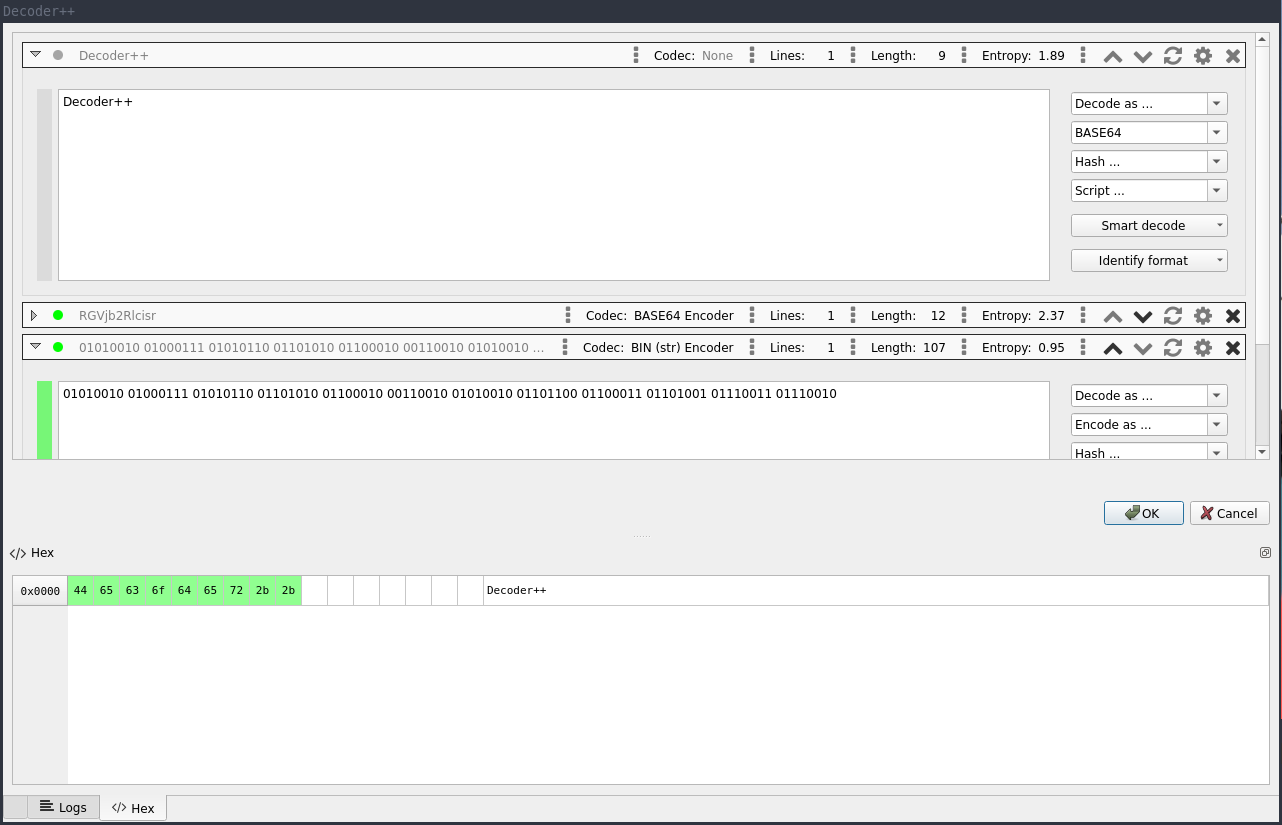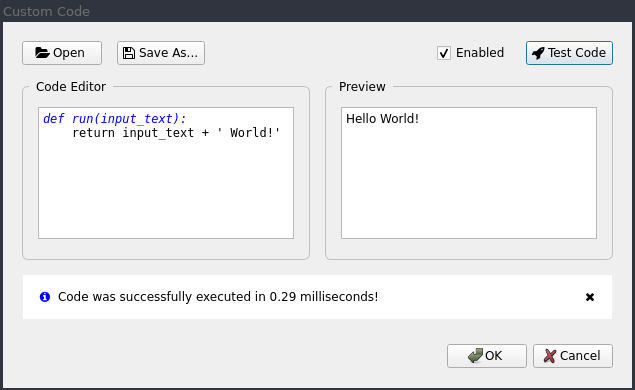Awesome

<a href="https://pypi.python.org/pypi/decoder-plus-plus"><img src="https://img.shields.io/pypi/v/decoder-plus-plus.svg"></a> <a href="https://pypi.python.org/pypi/decoder-plus-plus"><img src="https://img.shields.io/pypi/dm/decoder-plus-plus"></a> <a href="https://pypi.python.org/pypi/decoder-plus-plus"><img src="https://img.shields.io/pypi/pyversions/decoder-plus-plus.svg"></a>
Decoder++
Decoder++ is an extensible application designed for penetration testers, software developers, and anyone in between looking to effortlessly decode and encode data across various formats. It includes a wide range of preinstalled scripts and codecs, smart decoding and format identification, and supports both graphical user interface (GUI) and command-line interface (CLI) operations.
Quick Start
Get up and running with Decoder++ in just a few steps:
# Install using pip (latest:qt6)
pip3 install decoder-plus-plus[qt6]
# Or, for a qt5 backport:
pip3 install decoder-plus-plus[qt5]
# To leverage all features and plugins:
pip3 install decoder-plus-plus[extras]
For a detailed installation guide, including platform-specific instructions, see the Installation Guide.
Overview
This section provides an overview about the individual ways of interacting with
Decoder++. For additional usage information check out the Advanced Usage section.
Graphical User Interface
The graphical user interface provides two distinct interaction modes:
a main-window-mode and a dialog-mode.

While the main-window-mode supports tabbing, the dialog-mode has the ability to return the transformed
content to stdout ready for further processing.
As a result Decoder++ can enhance other tools/scripts
by providing a graphical user interface for flexible transformation of any input.

While Decoder++ processes the entire input text by default, it allows for selective data transformation as well.
To transform only a specific portion of your text, simply highlight the necessary text segment in the input field
and then apply the desired codec.

Command Line
In addition to the graphical user interface Decoder++ also provides a command line interface:
$ dpp -e base64 -h sha1 "Hello, world!"
e52d74c6d046c390345ae4343406b99587f2af0d
Codecs and Scripts
Decoder++ allows you to choose from a variety of codecs and scripts:
- Encode/Decode:
- Base16, Base32, Base45, Base64, Base64 (URL-safe)
- Binary, Gzip, Hex, Html, JWT, HTTP64
- Octal, Url, Url+, Zlib
- Hashing:
- Adler-32, Apache-Md5, CRC32, FreeBSD-NT
- Keccak224, Keccak256, Keccak384, Keccak512
- LM, Md2, Md4, Md5, NT, PHPass
- RipeMd160, Sha1, Sha3 224, Sha3 256, Sha3 384, Sha3 512
- Sha224, Sha256, Sha348, Sha512, Sun Md5
- Scripts:
- Caesar, CSS-Minify, Custom Code, Extract URLs, Filter-Lines
- Identify File Format, Identify Hash Format, JS-Beautifier, JS-to-XML, JQ
- JSONify, JSONPath, HTML-Beautifier
- Little/Big-Endian Transform, Reformat Text, Remove Newlines, Remove Whitespaces
- Search and Replace, Split and Rejoin, Unescape/Escape String, XPath
In cases where you require a bit more flexibility Decoder++ allows you to process your data with
custom scripts by using the Custom Code script:

Advanced Usage
This section provides additional information about how the command line interface can be used.
Command Line Interface
The commandline interface gives easy access to all available codecs.
To list them the -l argument can be used. To narrow down the search
the -l argument accepts additional parameters which work as filter:
$ dpp -l base enc
Codec Type
----- ----
base16 encoder
base32 encoder
base64 encoder
Decoder++ distinguishes between encoders, decoders, hashers and scripts.
Like the graphical user interface the command line interface allows the usage of multiple codecs in a row:
$ dpp "H4sIAAXmeVsC//NIzcnJ11Eozy/KSVEEAObG5usNAAAA" -d base64 -d gzip
Hello, world!
While encoders, decoders and hashers can be used right away, some scripts may require additional configuration.
To show all available options of a specific script add the help parameter:
$ dpp "Hello, world!" -s split_and_rejoin help
Split & Rejoin
==============
Name Value Group Required Description
---- ----- ----- -------- -----------
split_by_chars split_behaviour yes the chars used at which to split the text
split_by_length 0 split_behaviour yes the length used at which to split the text
rejoin_with_chars yes the chars used to join the splitted text
To configure a specific script the individual options need to be supplied as name-value pairs (e.g. search_term="Hello"):
$ dpp "Hello, world!" -s search_and_replace search_term="Hello" replace_term="Hey"
Hey, world!
Contribute
Feel free to open a new ticket for requesting features or reporting bugs. Also don't hesitate to issue a pull-request for new features/plugins. More information regarding Decoder++ development can be found in the Development Guide.
Thanks to
- Tim Menapace (RIPEMD160, KECCAK256)
- Robin Krumnow (ROT13)
Troubleshooting
Signals are not working on Mac OS
When starting Decoder++ in Mac OS signals are not working.
This might happen when PyQt6 is installed using homebrew.
Can not start Decoder++ in Windows using CygWin
When starting Decoder++ in CygWin an error occurs:
ModuleNotFoundError: No module named 'PyQt6'
This might happen even if PyQt6 is installed using pip.
Currently there is no fix for that. Instead it is recommended
to start Decoder++ using the Windows command line.
No Module PyQt6
When starting Decoder++ the error No module named 'PyQt6.sig' is displayed on the console.
This may happen when there are competing versions of PyQt6 installed. Reinstalling PyQt6 should fix this error.
$ sudo pip3 uninstall PyQt6
$ sudo pip3 install PyQt6
Missing Qt6 libraries
At least in Ubuntu 22.04 it might be necessary to install the following packages using apt:
apt install libqt6core6 libqt6network6 libqt6openglwidgets6 libqt6widgets6
X11-forwarding fails
In order to run dpp inside a container/virtual machine you may need to install the
qt6-qpa-plugins inside the container/virtual machine and configure the
QT_QPA_PLATFORM_PLUGIN_PATH accordingly:
apt install qt6-qpa-plugins
export QT_QPA_PLATFORM_PLUGIN_PATH=/usr/lib/x86_64-linux-gnu/qt6/plugins/platforms/
See the <a href="https://github.com/bytebutcher/decoder-plus-plus/tree/master/docker">Docker build and run scripts</a> for more information regarding how to build and run a Decoder++ Docker container.
Inspired By
- PortSwigger's Burp Decoder
Powered By
- QtPy / PyQt5 / PyQt6
- QtAwesome